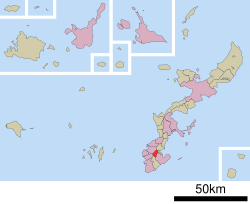Haebaru
南風原町 | |
|---|---|
Town | |
 | |
 Location of Haebaru in Okinawa Prefecture | |
| Coordinates: 26°11′28″N 127°43′43″E / 26.19111°N 127.72861°E | |
| Country | Japan |
| Region | Kyushu |
| Prefecture | Okinawa Prefecture |
| District | Shimajiri |
| Area | |
| • Total | 10.72 km2 (4.14 sq mi) |
| Population (October 1, 2016) | |
| • Total | 37,874 |
| • Density | 3,500/km2 (9,200/sq mi) |
| Time zone | UTC+09:00 (JST) |
| City hall address | 686 Aza Kanegusuku, Haebaru-chō, Shimajiri-gun 901-1195 |
| Website | www |
| Symbols | |
| Flower | Bougainvillea |
| Tree | Ebony |
Haebaru (南風原町, Haebaru-chō, Okinawan: フェーバル Feebaru[1]) is a town located in Shimajiri District, Okinawa Prefecture, Japan.[2]
As of 2016, the town has an estimated population of 37,874 and a density of 3,500 persons per km2. The total area is 10.72 km2. It is one of the only landlocked towns in Okinawa, but its central location ensures traffic and business remain healthy.
Haebaru is located in the south of Okinawa Island directly southeast of the prefectural capital of Naha.[2]
Haebaru is home to several pachinko parlors, as well as a skate and BMX ramp under the Okinawa Expressway. There is a large ÆON shopping complex and hypermarket.
Haebaru is the birthplace of Ultraman, a fictional television character that grows to a giant size and wrestles with giant monsters. The town is also home to a traditional Ryukyuan craft producing woven fabric or kasuri. It is produced at workshops in Haebaru.[3]
In June 2007 dugout bunkers used as military hospitals during the 1945 Battle of Okinawa were opened to the public for tours. In spring 2011, local junior high students began training as peace tour guides in a work experience program aiming to guide members of the public around the caves.[4]
- ^ 滝原康盛 Takihara Yasumori. 沖縄語会話集 日本語・沖縄語・ローマ字付き Okinawago Kaiwashū: Nihongo, Okinawago, Rōmaji-tsuki. (Okinawan Conversation Collection: Japanese, Okinawan, Romaji.) 那覇:沖縄芸能出版 Naha: Okinawa Geinō Shuppan. Heisei 6 (1994). p. 108. (in Japanese)
- ^ a b Cite error: The named reference
nwas invoked but never defined (see the help page). - ^ Cite error: The named reference
kasuriwas invoked but never defined (see the help page). - ^ Cite error: The named reference
jhswas invoked but never defined (see the help page).


